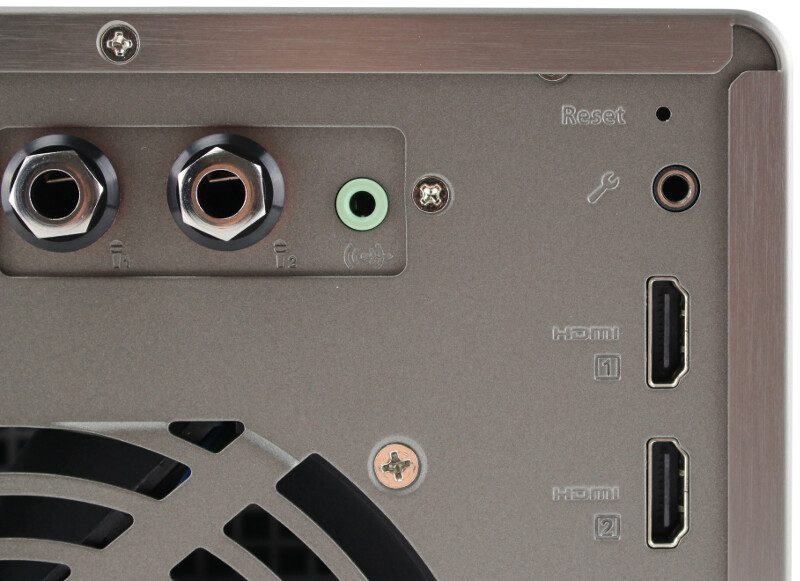QNAP TS-453A QTS-Ubuntu Combo NAS Review
A closer look
It is time to take a closer look at this awesome NAS’ physical features and we might as well start with the front and the buttons located here. There are two, one for power and one for the one-touch copy feature from USB.

It gets a little more interesting at the top where we find the two-line display with two control buttons. The display isn’t visible while it’s off, naturally, but I’ll show you a short video of the display in use instead. We can also spot the IR receiver below the buttons which supports both the RM-IR002 and RM-IR003 as well as MCE-compatible remote controls. There are three visible LED indicators in the display area: one for status, one for USB usage, and one for LAN usage. Not visible here are the last four LEDs that are hidden in the bar between the display area and the drive trays. There are four, one for each drive bay and they’re used for drive activity and notification.

The 2-line display allows for a lot of information to be displayed and it is a lot easier just to show it instead of making a long list that nobody reads anyway, so instead, here’s a short video with the display in use.
On the rear are a lot more features and it is probably the NAS with the highest amount of different connectors that I’ve seen. Starting at the top, we have two 6.3mm microphone connectors for dynamic microphones. Next to it is the line-out jack for amplifiers or headphone amplifiers.
Below the maintenance port and reset switch are the two HDMI outputs that can be used to connect two 4K monitors in either a duplicated or extended desktop configuration. Duplicating will display the same content on both displays, and extended desktop mode allows users to display applications over two displays for improved multitasking convenience and productivity. When displaying content using HDMI outputs, you can use the TS-453A as a multimedia player by using HD Station to enjoy rich apps including Kodi, HD Player, Plex Home Theater, YouTube, Chrome, Firefox, and more. Alternatively, you can choose to output the Linux operating system desktop to use the TS-453A as a PC.

Moving further down the device and we get to the three USB 3.0 ports that can be used for storage, wireless or tv capture dongles, printers, UPS, cameras, mice, keyboards, and almost anything else that works via USB. Below the USB ports are the four Gigabit Ethernet ports that can be assigned with all common link aggregation modes.

Turning the NAS upside down doesn’t reveal thát much, but there are a few things worth showing. We get four large feet that will make sure the NAS stays firmly where you place it and doesn’t transfer any vibrations between the surface and the NAS. This is also where we find serial numbers and the default LAN MAC addresses.

The drive trays are simple but effective. The pure metal tray will help transfer heat away from drives, aided by all the holes in them. The front ledge doesn’t feature a spring mechanism and the LEDs are placed directly in the NAS. Both things that help to cut a few costs and provide a cheaper NAS. It might have been a necessary thing with all the extra features this NAS has in order to keep it close to other devices price-wise.

The drive trays also support 2.5-inch drives and it’s clearly marked what screw holes to use here in order to line up the drives with the internal SATA connectors.

The included AC/DC power adapter comes from FSP Group that are well known for their quality PSUs. This one can deliver 8A at 12V which equals to 96 Watts – plenty for a device like this that will draw around 30W during normal usage.

Removing the cover of the TS-453A is easy, but taking it further apart gets tricky. Since no user needs to take it further apart then lift the cover, that’s not really an issue. We still get to see some of the features such as the daughterboard with the microphone plugs and an ALC262 chip. The LAN ports are controlled by Intel i210 chips and the HDMI ports by ASMedia chips.

But back to the one thing you’d want to open the NAS up for, upgrading or replacing the memory modules. Once the top is removed, the modules are located on the outter side of the PCB. The entire motherboard is protected by a film so you don’t accidentally short it out while upgrading.

Each memory module, in this case ADATA modules, is behind a flap that you simply bend down to gain access to the SO-DIMM slots.









